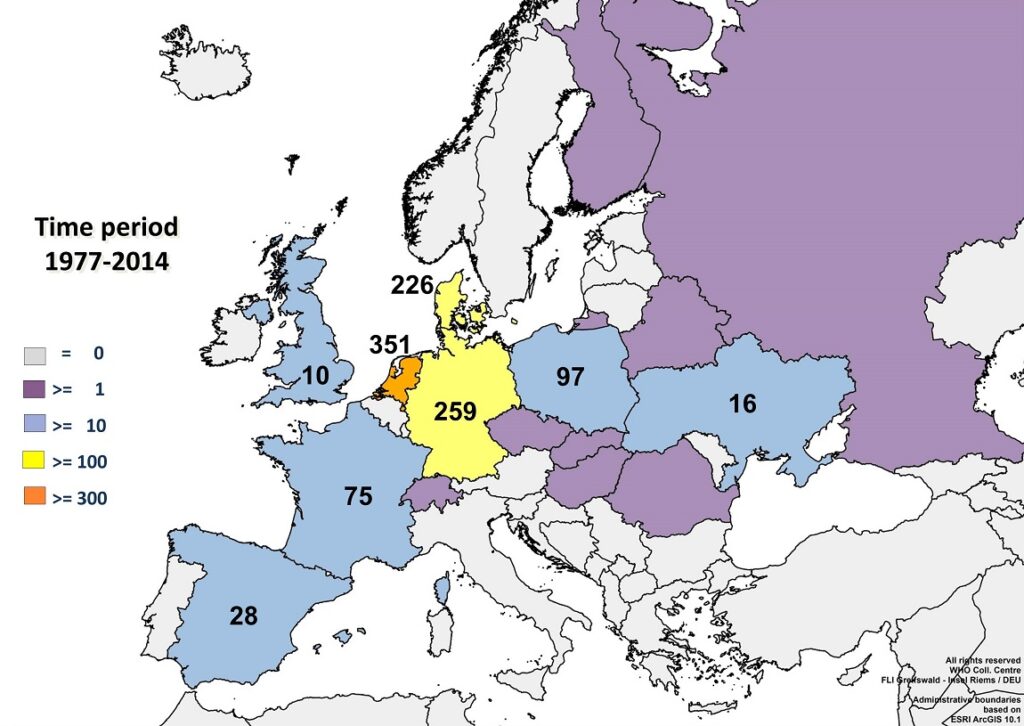Don’t touch bats with your bare hands!

Photo: Lena Godlevska
In May 2015 a bat that had been submitted to the Dutch Wildlife Health Centre (DWHC) for post-mortem investigation proved to be positive for the bat form of rabies after further testing was carried out at the Central Veterinary Institute (CVI) in Lelystad. This disease is caused by the European Bat Lyssa Virus (EBLV) which is closely related to the virus that causes the classic rabies seen in dogs and people.
In contrast to classic rabies which does not circulate in wild animals in the Netherlands, EBLV is regularly found in bats (particularly serotine bats, Eptesicus serotinus) in the Netherlands and some other European countries (see map). As rabies surveillance programs differ between countries the figures presented in the map cannot be compared directly but the map gives an idea of the occurrence and distribution of the disease.
 |
| Map showing the number of reported cases of bat rabies in European countries from 1977-2014 Source: |
People can become infected with the bat form of rabies via a scratch, lick or bite from an infected animal (i.e. contact with saliva). The World Health Organization (WHO) reports that, whilst the chance of people being infected with this form of the disease is very small, five people have died in Europe since 1977 as a result of infection: Ukraine (1977, 2002), Russia (1985), Finland (1985), Scotland 2002 [1]. Most victims had been in close contact with bats in their work or free-time [2].
To date, the bat form of rabies has been found in two of the 21 native species of bat in the Netherlands, namely the serotine (Eptesicus serotinus), and the pond bat (Myotis dasycneme). Of the bats that have been tested in recent years in the Netherlands, on average 15-20% of serotine and only very few pond bats are positive for EBLV [3]. In England it has also been found in Daubenton’s bat (Myotis daubentonii) and in Germany in the Natterer’s bat (Myotis nattereri) [2], both of which are found in the Netherlands.
In contrast to dogs infected with rabies, bats are not typically aggressive and do not tend to attack people. However, if sick bats are found or caught by a cat, people should be cautious about handling them given the risk that the animal may be infected with this virus. In particular, never handle them with bare hands; always wear thick gloves to protect yourself from bite or scratch wounds and avoid contact with saliva. For more Information about rabies In people, visit the website of the Centers for Disease Control and Prevention.
What to do if you find a bat
Never touch a bat with your bare hands. This is also the case if you believe it not to be a serotine or pond bat as it is difficult to distinguish between the different sorts and furthermore, it is possible that as in other countries, other sorts of bat are also infected with the virus in the Netherlands
Tips
- If there is a live bat in your house, open the windows and turn out the lights to encourage the bat to fly out
- If you find a bat on the ground do not touch it directly; put on gloves and try to place a box, flower pot or some other container over it before sliding a piece of cardboard under it. Release the bat outside.
- If the bat cannot fly or if you do not want to approach it then call the animal ambulance on 0900-0245.
- If you are bitten, scratched or licked by a bat rinse the site for a least 5 minutes under running water and wash it well with soap and contact your doctor immediately [4].
References
- M. de Rosa, O.F.J. Stenvers, J.A. Mak. (2014). De geschiedenis van rabiës bij dieren in Nederland. RIVM Infectieziekten Bulletin. 25 (3): 69 – 74.
- http://www.rivm.nl/Documenten_en_publicaties/Algemeen_Actueel/Uitgaven/Infectieziekten_Bulletin/Jaargang_25_2014/Februari_2014/Inhoud_Februari_2014/Kat_vangt_vleermuis_is_er_een_risico_op_rabi_s
- folder vleermuis op http://www.rivm.nl/Onderwerpen/R/Rabies



